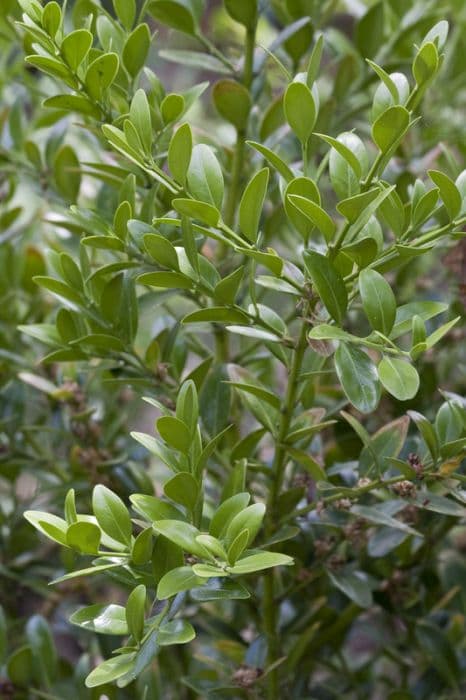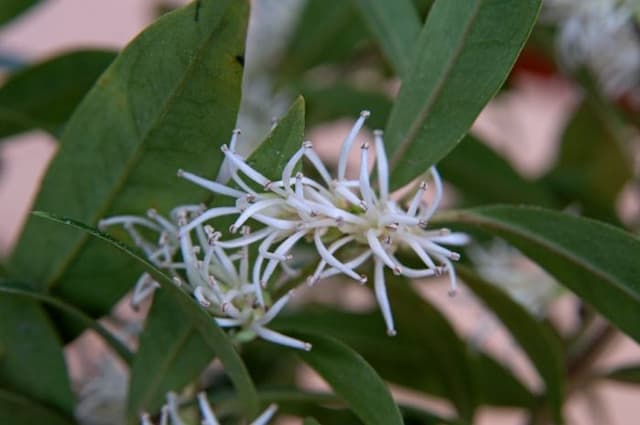Sweet Box Sarcococca wallichii

ABOUT
Sarcococca wallichii, commonly known as sweet box, is a lush evergreen shrub that boasts glossy, dark green leaves. These leaves are leathery in texture and lance-shaped, offering a year-round visual appeal. During the winter months, sweet box comes alive with clusters of small, creamy-white flowers that are incredibly fragrant, filling the air with a sweet, enchanting scent reminiscent of vanilla. After the flowering period, the plant produces spherical, glossy black berries that contrast beautifully with the foliage, a feature that persists into the following season and adds further interest to this aesthetically pleasing shrub. Sweet box has a dense, bushy habit, with branches often adorned with leaves all the way to the ground, making it an ideal choice for a low-maintenance ground cover or a background plant in a mixed border. Its subtle beauty and delightful aroma make it a valuable addition to gardens that focus on sensory experiences.
About this plant
 Names
NamesFamily
Buxaceae
Synonyms
Himalayan Sweet Box, Wallich's Sarcococca, Christmas Box, Sweet Box
Common names
Sarcococca wallichii.
 Toxicity
ToxicityTo humans
Sweet Box is generally considered non-toxic to humans. However, as with many plants, sensitive individuals may experience mild discomfort or an allergic reaction if they ingest parts of the plant or come into contact with its sap.
To pets
Sweet Box is also generally considered non-toxic to pets. Similar to humans, some animals may experience mild digestive upset if they consume parts of the plant. However, it is not known for having severe toxic effects on pets.
 Characteristics
CharacteristicsLife cycle
Perennials
Foliage type
Evergreen
Color of leaves
Dark green
Flower color
White
Height
3-4 feet (0.91-1.22 meters)
Spread
2-3 feet (0.61-0.91 meters)
Plant type
Shrub
Hardiness zones
7
Native area
Himalayas
Benefits
 General Benefits
General Benefits- Aesthetic Appeal: The Sweet Box adds visual interest to gardens with its evergreen foliage and compact, bushy growth habit.
- Fragrant Flowers: Sweet Box produces highly fragrant white flowers in late winter or early spring, which can be a pleasant addition to the garden when few other plants are in bloom.
- Low Maintenance: It requires minimal care once established, needing occasional watering during dry spells and little to no pruning.
- Shade Tolerance: This plant thrives in partial to full shade, making it ideal for planting under trees or in other low-light areas where other plants might struggle.
- Drought Resistance: Sweet Box is relatively drought-tolerant, making it suitable for xeriscaping or gardens in drier climates.
- Wildlife Attraction: The fragrant flowers can attract pollinators such as bees, while the berries can be a food source for birds.
- Ground Cover: It can be used effectively as a ground cover to help reduce weed growth and soil erosion due to its dense foliage.
- Year-Round Interest: With its evergreen leaves, Sweet Box provides color and structure to the garden throughout the year.
- Winter Blooming: The plant's winter flowering period adds interest to the garden during a season when most other plants are dormant.
 Medical Properties
Medical PropertiesThis plant is not used for medical purposes.
 Air-purifying Qualities
Air-purifying QualitiesThis plant is not specifically known for air purifying qualities.
 Other Uses
Other Uses- Sarcococca wallichii, commonly known as Christmas box, can be used in flower arrangements for its glossy green foliage and sweet-smelling flowers.
- The dense habit of Christmas box makes it suitable as a low natural screen or hedge in a shady garden spot.
- The berries of Christmas box may be used as a natural dye for fabric, yielding subtle green or yellow hues depending on the mordant used.
- Wood from Christmas box can be used in small woodworking projects as it is dense and can take a fine finish.
- The plant is sometimes included in sensory gardens for its fragrant flowers that add a pleasant olfactory experience.
- Garden designers use Christmas box for formal garden borders due to its evergreen nature and tidy growth habit.
- Christmas box can be planted in urban environments as it tolerates pollution well.
- Due to its resistance to deer browsing, Christmas box can be used in landscaping in areas with a high deer population.
- Christmas box’s berries attract birds, making it a valuable plant for bird-friendly gardens.
- It can be used in creating topiary forms as it responds well to pruning and maintains its shape over time.
Interesting Facts
 Feng Shui
Feng ShuiSweet box is not used in Feng Shui practice.
 Zodiac Sign Compitability
Zodiac Sign CompitabilitySweet box is not used in astrology practice.
 Plant Symbolism
Plant Symbolism- Strength in Adversity: Sarcococca wallichii, commonly known as Sweet Box, often signifies strength in adversity due to its hardy nature and ability to thrive in shade conditions where other plants might struggle.
- Protection: The dense foliage of Sweet Box can symbolize protection or shelter, as it provides a robust barrier when planted in gardens or hedges.
- Enduring Love: The Sweet Box emits a sweet fragrance during the winter months, it can be emblematic of enduring love that persists despite challenges or difficult times.
- Purity: The pristine white flowers that bloom on the Sweet Box might be associated with purity or innocence, common themes in floral symbolism.
- Revival and Hope: Since Sweet Box flowers in the winter, it can also represent revival and hope, being a sign that life continues and spring is on the horizon even in the cold, darker months.
 Water
WaterSweet Box prefers consistently moist, but well-drained soil. Water it thoroughly, allowing the soil to be damp but not waterlogged. During the growing season, usually in spring and summer, water it once a week with about 2 gallons for a medium-sized shrub. In fall and winter, reduce watering to once every two weeks or when the soil feels dry to the touch. If rainfall is sufficient, you can decrease the amount of supplemental watering.
 Light
LightSweet Box thrives best in partial shade to full shade. Its ideal spot would be under the canopy of larger trees or on the north side of a building where it can be protected from harsh afternoon sun. Ensure it has enough light to encourage flowering but avoid prolonged exposure to direct sunlight which can scorch the leaves.
 Temperature
TemperatureSweet Box is hardy and tolerates a range of temperatures but prefers a cooler climate. It can survive in temperatures as low as 0 degrees Fahrenheit and as high as 85 degrees Fahrenheit. The ideal temperature for this plant is between 60 to 75 degrees Fahrenheit. Avoid placing it in locations where temperatures can drop below freezing or rise to extremes that could stress the plant.
 Pruning
PruningPrune Sweet Box to maintain its shape and encourage bushier growth. The best time for pruning is in late winter or early spring before new growth starts. It typically doesn't require frequent pruning; once a year should suffice. Remove any dead or damaged branches and trim back lightly to shape the plant or control its size.
 Cleaning
CleaningAs needed
 Soil
SoilSweet Box prefers well-draining soil rich in organic matter with a soil pH ranging from 5.5 to 6.5. A good soil mix would be one part garden soil, one part peat moss or compost, and one part perlite or coarse sand to ensure proper drainage and aeration.
 Repotting
RepottingSweet Box should be repotted every 2 to 3 years or when it has outgrown its current pot, to refresh the soil and allow more room for root growth.
 Humidity & Misting
Humidity & MistingSweet Box thrives in moderate to high humidity levels, ideally around 40% to 60%, mimicking its natural understory habitat.
 Suitable locations
Suitable locationsIndoor
Provide filtered light, keep soil moist.
Outdoor
Plant in shade or part shade, sheltered.
Hardiness zone
7-9 USDA
 Life cycle
Life cycleSarcococca wallichii, commonly known as Sweet Box or Himalayan Sweet Box, begins its life cycle as a seed, which after dispersal and under suitable conditions of moisture and temperature, germinates to produce a small seedling. The seedling stage is characterized by the development of a root system and the emergence of the first shoots and leaves. As it matures into a young plant, it develops a more robust root system and a woody stem, with leaves that are a glossy green and capable of photosynthesis, leading to further growth. It reaches maturity and begins to flower, usually in winter, producing highly fragrant, small white flowers that attract pollinators and subsequently develop into small, shiny black berries by late summer or early fall. These berries carry the seeds which, once ripe, complete the cycle by falling to the ground or being dispersed by animals, thus enabling the propagation of the species. Over the years, Sarcococca wallichii grows slowly into a dense, evergreen shrub, maintaining its cycle through continuous flowering and fruiting under the right conditions.
 Propogation
PropogationPropogation time
Early spring
Propogation: Sarcococca wallichii, commonly known as Sweet Box, can be propagated by semi-hardwood cuttings. The optimal time to take these cuttings is in late summer to early fall, once the plant's new growth starts to harden. To propagate, a 4 to 6 inch (10 to 15 cm) cutting is taken from a healthy mother plant, ensuring that at least a couple of leaves are left at the top. The bottom cut should be just below a node, which is where the leaves emerge from the stem. After removing the lower leaves, the cutting should be dipped in rooting hormone to encourage root growth and then inserted into a pot filled with a mix of perlite and peat moss. The cutting requires consistent moisture and should be kept in a well-lit area without direct sunlight until roots have established, which usually takes several weeks. After rooting, the new plant can be potted up individually and gradually acclimatized to outdoor conditions before planting out in its permanent location the following spring.






![Sweet box [Winter Gem]](/_next/image?url=https%3A%2F%2Fplants-admin.emdemapps.com%2Fimages%2Fplants%2F%2Fimages%2F604b6267b442c.png&w=640&q=75)


